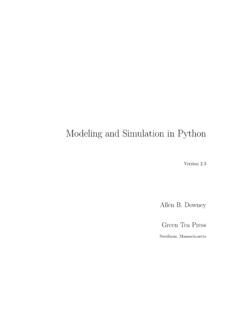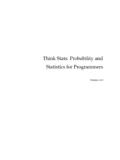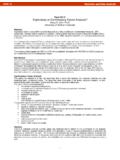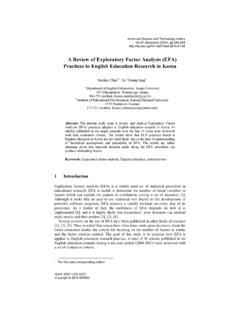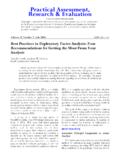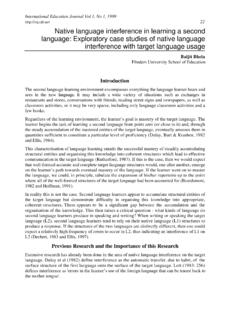Transcription of Think Stats - Green Tea Press
1 Think Stats exploratory Data Analysis in Python Version Think Stats exploratory Data Analysis in Python Version Allen B. Downey Green Tea Press Needham, Massachusetts Copyright c 2014 Allen B. Downey. Green Tea Press 9 Washburn Ave Needham MA 02492. Permission is granted to copy, distribute, and/or modify this document under the terms of the Creative Commons Attribution-NonCommercial-ShareAlike Inter- national License, which is available at by-nc- The original form of this book is LATEX source code. Compiling this code has the effect of generating a device-independent representation of a textbook, which can be converted to other formats and printed. The LATEX source for this book is available from Preface This book is an introduction to the practical tools of exploratory data anal- ysis. The organization of the book follows the process I use when I start working with a dataset: Importing and cleaning: Whatever format the data is in, it usually takes some time and effort to read the data, clean and transform it, and check that everything made it through the translation process intact.
2 Single variable explorations: I usually start by examining one variable at a time, finding out what the variables mean, looking at distributions of the values, and choosing appropriate summary statistics. Pair-wise explorations: To identify possible relationships between vari- ables, I look at tables and scatter plots, and compute correlations and linear fits. Multivariate analysis: If there are apparent relationships between vari- ables, I use multiple regression to add control variables and investigate more complex relationships. Estimation and hypothesis testing: When reporting statistical results, it is important to answer three questions: How big is the effect? How much variability should we expect if we run the same measurement again? Is it possible that the apparent effect is due to chance? Visualization: During exploration, visualization is an important tool for finding possible relationships and effects. Then if an apparent effect holds up to scrutiny, visualization is an effective way to communicate results.
3 Vi Chapter 0. Preface This book takes a computational approach, which has several advantages over mathematical approaches: I present most ideas using Python code, rather than mathematical notation. In general, Python code is more readable; also, because it is executable, readers can download it, run it, and modify it. Each chapter includes exercises readers can do to develop and solidify their learning. When you write programs, you express your under- standing in code; while you are debugging the program, you are also correcting your understanding. Some exercises involve experiments to test statistical behavior. For example, you can explore the Central Limit Theorem (CLT) by gener- ating random samples and computing their sums. The resulting visu- alizations demonstrate why the CLT works and when it doesn't. Some ideas that are hard to grasp mathematically are easy to under- stand by simulation. For example, we approximate p-values by running random simulations, which reinforces the meaning of the p-value.
4 Because the book is based on a general-purpose programming language (Python), readers can import data from almost any source. They are not limited to datasets that have been cleaned and formatted for a particular statistics tool. The book lends itself to a project-based approach. In my class, students work on a semester-long project that requires them to pose a statistical question, find a dataset that can address it, and apply each of the techniques they learn to their own data. To demonstrate my approach to statistical analysis, the book presents a case study that runs through all of the chapters. It uses data from two sources: The National Survey of Family Growth (NSFG), conducted by the Centers for Disease Control and Prevention (CDC) to gather information on family life, marriage and divorce, pregnancy, infer- tility, use of contraception, and men's and women's health. (See ). How I wrote this book vii The Behavioral Risk Factor Surveillance System (BRFSS), conducted by the National Center for Chronic Disease Prevention and Health Promotion to track health conditions and risk behaviors in the United States.
5 (See ). Other examples use data from the IRS, the Census, and the Boston Marathon. This second edition of Think Stats includes the chapters from the first edition, many of them substantially revised, and new chapters on regression, time series analysis, survival analysis, and analytic methods. The previous edition did not use pandas, SciPy, or StatsModels, so all of that material is new. How I wrote this book When people write a new textbook, they usually start by reading a stack of old textbooks. As a result, most books contain the same material in pretty much the same order. I did not do that. In fact, I used almost no printed material while I was writing this book, for several reasons: My goal was to explore a new approach to this material, so I didn't want much exposure to existing approaches. Since I am making this book available under a free license, I wanted to make sure that no part of it was encumbered by copyright restrictions. Many readers of my books don't have access to libraries of printed ma- terial, so I tried to make references to resources that are freely available on the Internet.
6 Some proponents of old media Think that the exclusive use of electronic resources is lazy and unreliable. They might be right about the first part, but I Think they are wrong about the second, so I wanted to test my theory. viii Chapter 0. Preface The resource I used more than any other is Wikipedia. In general, the arti- cles I read on statistical topics were very good (although I made a few small changes along the way). I include references to Wikipedia pages through- out the book and I encourage you to follow those links; in many cases, the Wikipedia page picks up where my description leaves off. The vocabulary and notation in this book are generally consistent with Wikipedia, unless I had a good reason to deviate. Other resources I found useful were Wol- fram MathWorld and the Reddit statistics forum, r/statistics. Using the code The code and data used in this book are available from https://github. com/AllenDowney/ThinkStats2. Git is a version control system that allows you to keep track of the files that make up a project.
7 A collection of files under Git's control is called a repository. GitHub is a hosting service that provides storage for Git repositories and a convenient web interface. The GitHub homepage for my repository provides several ways to work with the code: You can create a copy of my repository on GitHub by pressing the Fork button. If you don't already have a GitHub account, you'll need to create one. After forking, you'll have your own repository on GitHub that you can use to keep track of code you write while working on this book. Then you can clone the repo, which means that you make a copy of the files on your computer. Or you could clone my repository. You don't need a GitHub account to do this, but you won't be able to write your changes back to GitHub. If you don't want to use Git at all, you can download the files in a Zip file using the button in the lower-right corner of the GitHub page. All of the code is written to work in both Python 2 and Python 3 with no translation.
8 I developed this book using Anaconda from Continuum Analytics, which is a free Python distribution that includes all the packages you'll need to run the Using the code ix code (and lots more). I found Anaconda easy to install. By default it does a user-level installation, not system-level, so you don't need administrative privileges. And it supports both Python 2 and Python 3. You can download Anaconda from If you don't want to use Anaconda, you will need the following packages: pandas for representing and analyzing data, org/;. NumPy for basic numerical computation, ;. SciPy for scientific computation including statistics, http://www. ;. StatsModels for regression and other statistical analysis, http://. ; and matplotlib for visualization, Although these are commonly used packages, they are not included with all Python installations, and they can be hard to install in some environments. If you have trouble installing them, I strongly recommend using Anaconda or one of the other Python distributions that include these packages.
9 After you clone the repository or unzip the zip file, you should have a folder called ThinkStats2/code with a file called If you run , it should read a data file, run some tests, and print a message like, All tests passed. If you get import errors, it probably means there are packages you need to install. Most exercises use Python scripts, but some also use the IPython notebook. If you have not used IPython notebook before, I suggest you start with the documentation at I wrote this book assuming that the reader is familiar with core Python, including object-oriented features, but not pandas, NumPy, and SciPy. If you are already familiar with these modules, you can skip a few sections. x Chapter 0. Preface I assume that the reader knows basic mathematics, including logarithms, for example, and summations. I refer to calculus concepts in a few places, but you don't have to do any calculus. If you have never studied statistics, I Think this book is a good place to start.
10 And if you have taken a traditional statistics class, I hope this book will help repair the damage.. Allen B. Downey is a Professor of Computer Science at the Franklin W. Olin College of Engineering in Needham, MA. Contributor List If you have a suggestion or correction, please send email to If I make a change based on your feedback, I. will add you to the contributor list (unless you ask to be omitted). If you include at least part of the sentence the error appears in, that makes it easy for me to search. Page and section numbers are fine, too, but not quite as easy to work with. Thanks! Lisa Downey and June Downey read an early draft and made many correc- tions and suggestions. Steven Zhang found several errors. Andy Pethan and Molly Farison helped debug some of the solutions, and Molly spotted several typos. Dr. Nikolas Akerblom knows how big a Hyracotherium is. Alex Morrow clarified one of the code examples. Jonathan Street caught an error in the nick of time.


